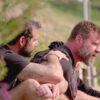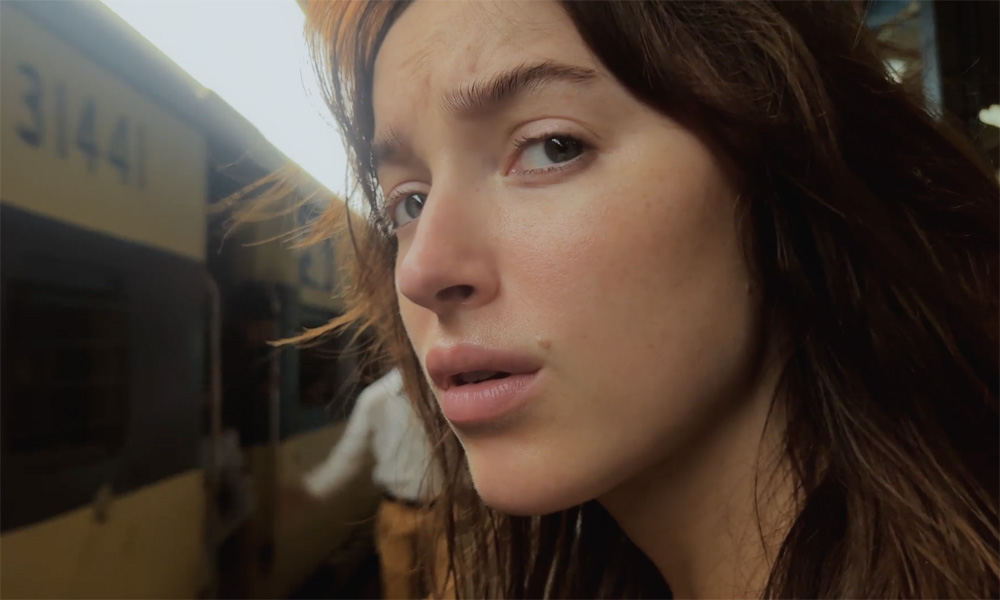It could be construed as a bit of an inside joke on “Inheritance” that Maya (Phoebe Dynevor) is a mild kleptomaniac, habitually tucking small items into her pocket from souvenirs at the great pyramids of Egypt to a bottle of gin downstairs from her walk-up apartment in New York. She goes undetected when she keeps the theft small, but it is in service of a much larger heist in the latest from Neil Burger, who wondered if he could turn the entire world into a film set, discretely following Dyvenor around in big public spaces for a global espionage thriller in which you actually feel as if you’re the spy.
It isn’t only Maya that feels as if she has to look over her shoulder, but Dyvenor herself when a motorcycle chase through the streets of Delhi or a walk in downtown South Korea doesn’t appear to have been cordoned off for the purposes of a film production and it adds an extra thrill to the globetrotting tale of a young woman hoping to reconnect with her enigmatic father Sam (Rhys Ifans) after the death of her mother. Against her better judgment, she accepts an invitation to work with him on a real estate deal in Cairo upon reuniting at her mother’s funeral, and having been the one to provide 24 hour-a-day care to her in her dying days, the thought of leaving the country sounds nice. However, while she’s always had her doubts about Sam, whose commitment to his career could be considered neglect for his family, she couldn’t expect such a level of deception about what he does upon learning that he’s actively been working for the government on high-security matters, unable to meet with her after she’s crossed the Atlantic when he’s been abducted and she has to figure out why.
Burger, who has shown a flair for formal experimentation with “Limitless” and an affection for sleight-of-hand with “The Illusionist,” gets to go aggro with “Inheritance” as Dyvenor is thrown into one wild situation after another as Maya with only Sam’s iPad to hint at who and where he really is. On planes, trains and motorcycles, the film doesn’t only feel as if it’s conveying an adventure, but one itself in its making when Burger and cinematographer Jackson Hunt come up with unconventional camerawork to properly capture the action and the interactions between a small cast with real people and environments carries a live-wire unpredictability. With the film racing into theaters this week, the director graciously spared a few minutes to talk about keeping the suspenseful drama on the move, what led him to embark on such a risky maneuver at this point in his career and when he had to draw the line between a great scene for the movie and a potential night in jail.
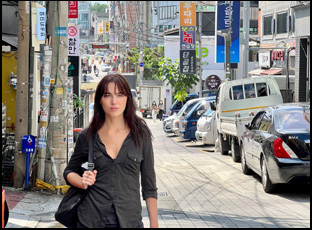
It was a huge adventure and so fun to make. It’s not a COVID movie, but the original idea came to me during [that time], but there was a story that I read about how there was nobody on the streets in Europe and around the world and I wanted to go see that. I didn’t want to make a documentary, but I wanted to make a a narrative movie that went from country to country to see the new normal. Then things started opening up a bit, and I still had the idea and I felt if you go and shoot in a place with a full camera crew, you disrupt the place. People come and look at you, so you don’t see what the place is really like. You change it. So I thought the only way that you could really get a look at the new normal and how people really were was with an iPhone because everybody’s carrying an iPhone around. The technology also had gotten so good that I thought I could make a theatrical film on it.
So with Olen Steinhauer, a spy novelist, I created this story that goes around the world from New York to Cairo to Delhi, to Seoul and back to New York, and we use the iPhone, not as a gimmick or as a substitute for a motion picture camera, but because it gave us access. It meant that we could walk through a crowded Cairo market and nobody would look at us or shoot a dialogue scene on an airplane and get away with it. And that’s what it does. The movie has a stolen aesthetic to it where we stole the shots.
It has a real liveliness as a result and it reminded me of “Limitless” where you went a bit wild with the camerawork too. What was it like finding the balance of practicality and creating a real style?
it’s a little different from “Limitless” because there’s so many visual effects and things that are morphing [in that film], but what’s related to “Limitless” is you’re so much in the head of somebody. I wanted to be in the head of Phoebe Dyvenor’s character and even though it is interested in the world and seeing the world flow by, it’s not a documentary. It’s very much in her shoes and in her experience and what it is to be her. Because we were trying to be under the radar — and even with an iPhone, if you stick around for too long, shooting a wide shot and then an over the shoulder shot [as you would in] conventional film, language, we were going to get noticed — so we came up with this other style where that flowed more around [the actors] and into them. It has a caught live feel, almost the way you would like film your child’s birthday party, not in a primitive way, but in a flowing way that gives the movie a kind of different visual language.
It gives you that “you are there” quality and, but by doing that, you’re creating a different look for the movie and it also changed the way the actors acted. They always had to be on. So I would walk Phoebe down the street and then I would say, “Stand here.” And then I would walk away and just gesture to her, “Come on,” and then she would start walking. She just had to drop into character out of the blue and whatever happened, if somebody bumped her or a siren went by or somebody came up and spoke to her, she had to go with that and be in character for that. And she always did. They never dropped character. They were great.
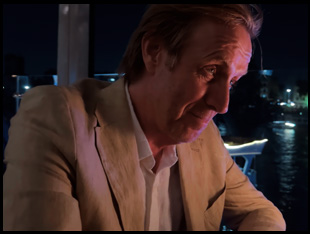
I felt quite certain that this was the way to make the movie and I just needed to find the right collaborators who understood. It was interesting. Phoebe obviously had done “Bridgerton” and “Fair Play” where she’s playing more uptight, conservative characters whereas Maya in my movie is kind of a badass. She’s self-destructive. She’s trouble. She’s a bit lost. And I sensed in Phoebe that she could do it and that she was eager to do it. And I’m forever thankful that she was game to do it because, as you say, it was a crazy ask. Rhys [Ifans], however, was like, “Sounds good to me.” In a way, he normalized it for her as well and for the other actors because he was like, “This is crazy and this is great.”
The motorcycle chase is unlike any I’ve seen. What was it like to design?
Because the movie has a different visual language to it, it wasn’t a movie that was ever going to show a closeup of the wheel of the motorcycle or of the hand revving the throttle and then a closeup of the gear shift or something like that. It was always going to be with [Maya], so really what I wanted to do was just have one camera on her face for the entire thing. We don’t quite do that the whole way, but we do it about 80% of the time and I just thought that there was an energy with that to see “Whoa, those cars are right behind her.” She’s going down these narrow streets and you see her emotion that she’s freaked out. Not only is she on a dangerous motorcycle ride, but she might get caught by people who she has no idea what they’re going to do to them. But [the sequence] was very designed and the route that they took was all marked out, but it was also on all open roads in Delhi. We had a little bit of a perimeter that was helping us, and it was safe because in a way nobody ever gets going that fast in Delhi because there’s so much traffic, but it was crazy.
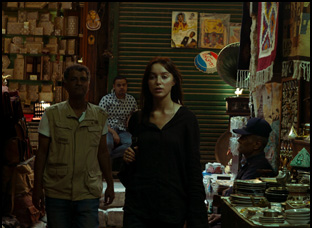
Yeah, there were people when she’s walking across Cairo at like 3 a.m. who shouted at [Phoebe Dyvenor] on on a passing motorcycle and she responded. And it’s actually not in the movie, but when [around the scene when] she’s drinking on the street, which is on 8th Avenue in New York, there was a cameraman just a little ways away from her, and he was all in black and nobody seemed to notice him and I was a few feet away and I’m looking at an iPad, looking at a transmission of what’s being filmed. And I looked down and I realized three of the biggest New York policemen approaching her, like, “What the hell do you think you’re doing?” and grabbing the bottle away from her. And [Phoebe] stayed in character the whole time. She was like, “What does it look like I’m doing?” And they’re like,”Why are you drinking tequila?”And [she said] “Because I like tequila.” And then at a certain point just before they were going to arrest her, I needed to step in and be like, “No, no, no, this is a movie. It’s okay.”
“Inheritance” opens in theaters on January 24th.
